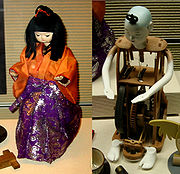The following is a short description of the history of automata. It can be broken down into 3 rough time frames, Ancient history, 15th-19th Century and Modern times

However, information gleaned from recent scans of the fragments indicate that it may have come from the colonies of Corinth in Sicily and implies a connection with Archimedes.
Other historic examples Other notable examples of automata include Archytas's dove, mentioned by Aulus Gellius, Noct. Att. L. 10; and Regiomontanus's wooden eagle and iron fly, the former which, as Hakewill relates, flew forth of the city, met the emperor, saluted him, and returned. It is said that the iron fly flew out of Regiomontanus's hands at a feast, and taking a round, returned to him.[17] Similar Chinese accounts of flying automata are written of the 5th century BC Mohist philosopher Mozi and his contemporary Lu Ban, who made artificial wooden birds (ma yuan) that could successfully fly according to the Han Fei Zi and other texts.[18] The Smithsonian Institution has in its collection a clockwork monk, about 15 in (380 mm) high, possibly dating as early as 1560. The monk is driven by a key-wound spring and walks the path of a square, striking his chest with his right arm, while raising and lowering a small wooden cross and rosary in his left hand, turning and nodding his head, rolling his eyes, and mouthing silent obsequies. From time to time, he brings the cross to his lips and kisses it. It is believed that the monk was manufactured by Juanelo Turriano, mechanician to the Holy Roman Emperor Charles V.[19] |
Etymology The word Automaton is derived from the Greek αὐτόματος, automatos, “acting of one’s own will”. It is more often used to describe non-electronic moving machines, especially those that have been made to resemble human or animal actions, such as the jacks on old public striking clocks, or the cuckoo and any other animated figures on a cuckoo clock.  Project by: 1. Alma V. Roma 2. Mythy Pacala 3.Jennifer Gellena
|